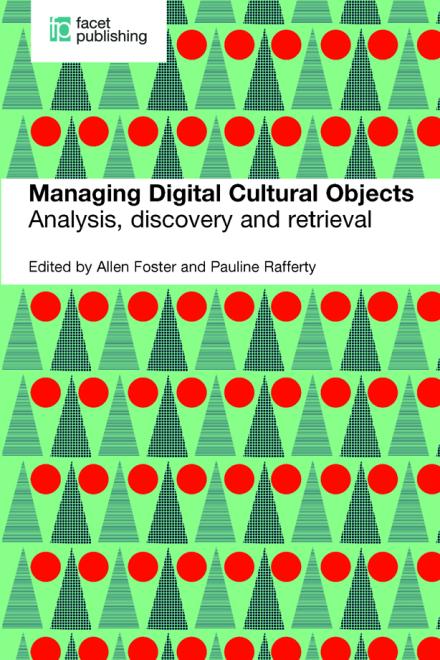Book Review: Managing Digital Cultural Objects: Analysis, discovery and retrieval
Submitted by sharragrow on

Review by Louise Lawson
Managing Digital Cultural Objects: Analysis, discovery and retrieval
Edited by Allan Foster and Pauline Rafferty
Facet Publishing, July 2016
256 pages / £59.95 / Paperback
ISBN:978-1-85604-941-2 (Paperback)
http://www.facetpublishing.co.uk/title.php?id=049412#.XLipEi-B3EY
At the outset of the publication, the editors state their aim to create “a platform to inspire and develop creative and innovative research projects at masters and PhD levels.” Their volume certainly achieves this goal, but it would also prove useful for those directly working to preserve digital cultural objects. This volume brings together a range of experts within the field of digital preservation in order to address the topic of analysis, discovery and retrieval of cultural objects. It beautifully draws upon the theoretical and academic aspects of digital culture and works to balance this focus with contributions from practitioners working within the digital preservation sector. The adjunct of case studies illuminates the work of managing digital cultural objects. The book is split into three parts, each providing a wealth of information. As such the book would be useful for anyone wishing to delve further into this topic or perhaps for those seeking inspiration for a research project.
PART 1: ANALYSIS AND RETRIEVAL OF DIGITAL CULTURAL OBJECTS
In part 1 the reader is introduced to key theoretical issues relating to digital indexing, data modelling and user-generated content. The first chapter works to set the scene and provides a useful framework for considering the issues around analysis and retrieval, the challenges of semantics and communication practices and the ways in which frameworks are moving towards accommodating such practices. The second chapter explores the importance of ensuring clear aims of digital object creation and their subsequent discovery focusing on the importance of modelling data, metadata requirements to fulfil any agreed aims. The chapter outlines key areas to consider when thinking about the creation of digital objects across both the digital object itself (significant properties and needs for unique, persistent identifiers) and metadata (function, standardisation, structures and content rules). It is here where we are first introduced to the semantic web and linked data. Part 1 concludes with an exploration of the potentiality of user-generated content as cultural objects and the ways in which they may become sources for important moments across history, with a focus on Wikipedia and Twitter.
PART 2: DIGITIZATION PROJECTS IN LIBRARIES, ARCHIVES AND MUSEUMS: CASE STUDIES
Part 2 comprises three case studies, each written by practitioners. First is an exploration of the analysis and evaluation of image-based descriptors of artworks by the Welsh artist Sir John ‘Kyffin’ Williams in order to derive metadata. It uses images pulled from various sources to estimate metadata from these descriptors. It is a fascinating case study that works to provide a date or date range for paintings with the use of meaningful metadata from the pictorial properties of an artwork. The second case study focuses on the British Library and how it approaches the management and preservation of digital collections. Reflecting on the collection size, scale, variation and how its collection is increasing, the case study outlines the strategy for digital preservation with a focus on the research and development programme which assists in the delivery of said strategy. It provides an informative reflection on areas of work and exploration with a look ahead to future work streams. The final case study reflects on the preservation of audio content with a look at how audio archivists have worked to digitise and preserve audio content and outlines the need for the digitisation of existing carriers to a sustainable file-based environment; this provides useful pointers for anyone who may need to make this argument, exploring both carrier and technological obsolescence. The key aspect of this chapter is ensuring that preservation is part of the life cycle of a digital object or collection.
PART 3: SOCIAL NETWORKING AND DIGITAL CULTURAL OBJECTS
The concluding part of the book focuses on social networking and digital cultural objects. The reader is introduced to digital images and photographs through Flickr, Facebook and other social networking sites. It provides a comprehensive focus on retrieval methods for digital images from concept-based, content-based, web-scale retrieval and the challenges of retrieval with the sheer volume of images on the web that are available to index. It also provides an in-depth exploration of “tags” and “tagging” from their nature, quality, models of content and meaning. Part 3 also discusses themes around searching and classification within a web music collection. It looks at duplication detection, introducing ‘fingerprint-ing’, which is a prevalent method of identification in the music domain; this is centred around a project that looked at 350,000 audio tracks. Concluding the publication is an exploration of film retrieval on the web. It touches on both technical and strategic issues, using case studies that employ five representative film retrieval systems including BFI, AFI, YouTube, Netflix and IMDb.
All in all, a useful volume for anyone working with digital cultural objects and for anyone looking for that inspiration for research within their studies.
AUTHOR BYLINE
Louise Lawson is conservation manager for time-based media at Tate. She is responsible for the strategic direction, development and delivery of all aspects relating to time-based media conservation for the collection. This requires working across a wide range of projects and programmes including exhibitions, displays, acquisition, loan-outs and collection care initiatives.